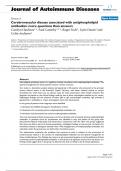Exam (elaborations)
Cerebrovascular disease associated with antiphospholipid antibodies: more questions than answers
- Course
- Institution
emographics Patients fulfilling Sapporo classification criteria Group with transiently positive aCL Group with low positive aCL Number of patients N = 26 N = 7 N = 12 Median age (years) 37.6 (6–63) 35.4 (16–51) 41.6 (19–59) Number of episodes/patient 1 194 6 2 736 Clinical prese...
[Show more]



